Osteochondrosis is considered today as one of the most common diseases, often affecting women over 25 years old. The disease is characterized by an acute, rapid course, especially when comparing the course of the disease in male patients.
The pathological processes that accompany the disease are the destruction of articular tissue, intervertebral discs. Pathology in 30% of cases is the cause of the headache. If the symptoms of cervical osteochondrosis appear in women, you should seek medical help immediately, this will help avoid further development of the disease.

What is cervical osteochondrosis
Osteochondrosis is a chronic disease, associated with damage to one or more parts of the spine. Depending on this, the clinical manifestations of the disease vary.
The main load falls on the lower back, but with the loss of the cervical region, there are many more problems. This is due to the anatomical features of the body, in the region of the cervix there are many fibers and nerve endings, there are also vessels on which the blood circulation in the brain depends.

The cervical region is considered the most vulnerable because of the proximity of the vertebrae and their proximity to the arteries involved in delivering nutrients to the brain. Dislocation of the vertebrae leads to compression of the nerve roots and arteries, after which changes occur in the intervertebral cartilage, hernias and extensions develop. These changes in the intervertebral discs often have an age-related character, the disease can appear even at a young age.
Predisposing factors
There are a large number of reasons for the development of osteochondrosis of the female cervix, predisposing factors include the following:
- taking hormonal medications - this leads to metabolic disorders;
- increased load on the spine and spinal muscles (develops as a result of an improperly organized workplace, when working in hazardous industries or with weightlifting, professional sports);
- diet violation, use of unhealthy foods, lack of nutrients;
- Insufficient water intake (clean, without additives and harmful impurities) - this leads to drying of cartilage tissue, ligaments, which leads to blockage of the body with toxins;
- low physical activity - against the background of lack of physical exercise, there is a violation of blood circulation to the muscles, insufficient nutrition of the intervertebral discs;
- genetic predisposition, congenital curvature of the spine;
- previous diseases (arthritis, osteoarthritis, neuralgia, vasospasm, etc. );
- transferred spinal cord injuries;
- constant stress - they are often psychosomatic in nature, against the background of tension, uncontrolled muscle contraction occurs, as a result, circulatory processes, lymphatic fluid flow slows down, deposits of toxins and toxins are observed.

Secondary risk factors:
- wrong spine position during sleep and rest, wrong choice of mattress and pillow;
- sleeping without a pillow;
- pregnancy;
- overweight.
Age - as the body ages, vertebral wear occurs, cartilage tissue is consumed, calcium is washed away, improper distribution of body weight on the legs, uneven load on the spine.
Symptoms of cervical chondrosis in women
Osteochondrosis of the cervix can be asymptomatic for a long time, many attribute the limitation of motor activity to fatigue, pain in the early stages of the disease is often absent.

The appearance of pain is often accompanied by poor sleep, frequent stress. In some cases, the signs of common cervical osteochondrosis in women appear quite quickly. The day before a woman may feel well and the next day the strong pain does not allow her to move freely, to the point of inability to lift her head from the pillow. This condition is a reason to seek medical help, at this stage, you can easily cope with the signs of the disease.
General symptoms of the disease
The symptoms of the acute phase of cervical osteochondrosis in women are more pronounced. Cartilage puts pressure on nerve roots, puts pressure on arteries that run along the spine. There is a risk of short-term memory loss, due to oxygen starvation, frequent fainting occurs. Lack of therapy in the presence of pain, numbness in the shoulder area, tingling sensation in the fingers and other symptoms can lead to paralysis.

Reflex syndrome
Manifestations of cervical osteochondrosis in women are often associated with reflex syndromes, the symptoms of which occur against the background of constant irritation of spinal cord receptors, as a result of which neurons are reflexively in an excited state.
This leads to malnutrition, metabolic processes, at the same time blood vessels and nerves are congested.
Reflex syndromes are divided into:
- Pain - back pain, neck pain, back of the head, concomitant neck pain, shoulder / forearm.
- Muscle tonic - constant muscle tension, resulting in oxygen starvation, swelling, seals.
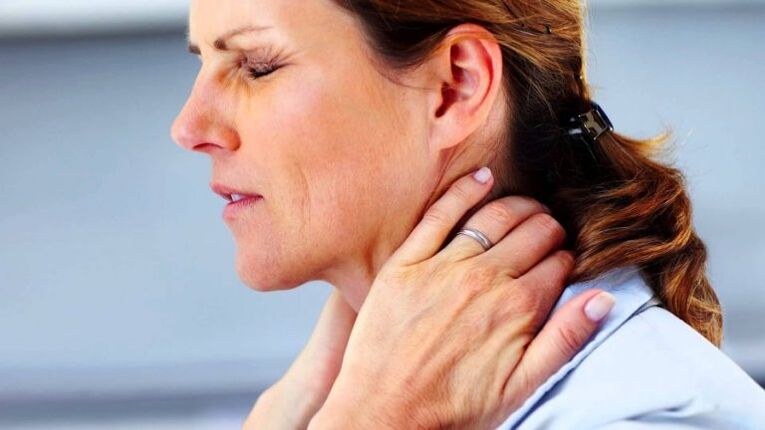
Periodically, spasms can also occur in the muscles of the head, in the cervical region and in the shoulder girdle.
In the initial stage of disease development, oblique lower back muscle syndromes, scapular-costal syndrome, vertebral artery syndrome, scaling muscle tension often occur.
radicular syndrome
With osteochondrosis of the cervical spine in women, radicular syndrome often occurs, which is accompanied by compression of the vessels of the nerve roots of the spinal cord. Pathology is associated with impaired movements in the hands, loss of sensation. In this case, there are also violations of the functioning of internal organs (pathology of urination, sexual dysfunction, hypertension, memory impairment). Damage to blood vessels can occur suddenly, with sudden movements in the affected area.
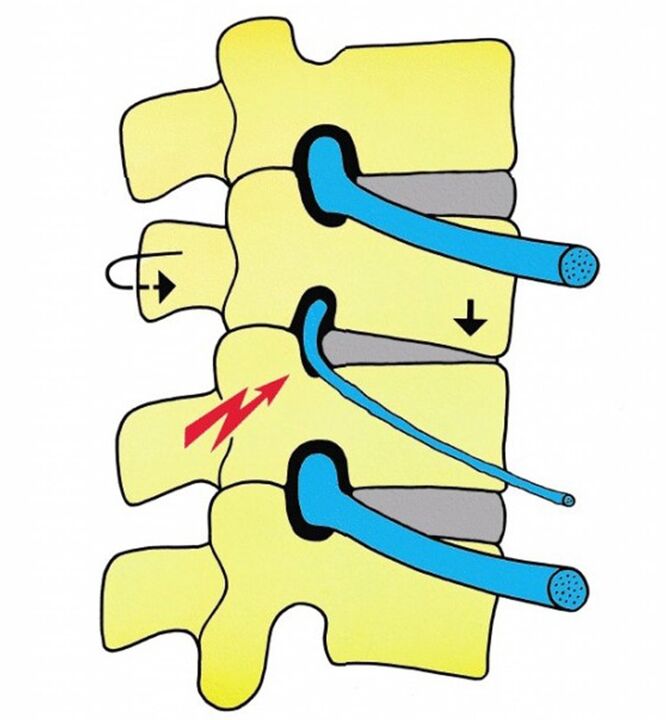
Vascular syndrome
Against the background of symptoms of compression of the vessels of the spinal cord, in women appears a symptom of osteochondrosis of the cervical spine, in extreme cases, an ischemic spinal stroke develops. This complication is accompanied by a violation of motor activity of the limbs, there is a decrease in sensitivity, a deterioration in the functioning of internal organs. Sometimes the organs stop functioning and if the kidneys fail, there is a high probability of death.

Stages of development of osteochondrosis
There are four stages of the disease, all of which are associated with certain pathological changes.
1 phase
In the first stage of disease development, damage to the pulpal nucleus of the intervertebral disc is observed. This phenomenon occurs against the background of a violation of metabolic processes in the body, as a result of dehydration, the core dries up, shrinks in size and becomes less stable. The spine becomes more sensitive to physical stress, there is no pain syndrome at this stage. Diagnosis at this stage does not require medication.
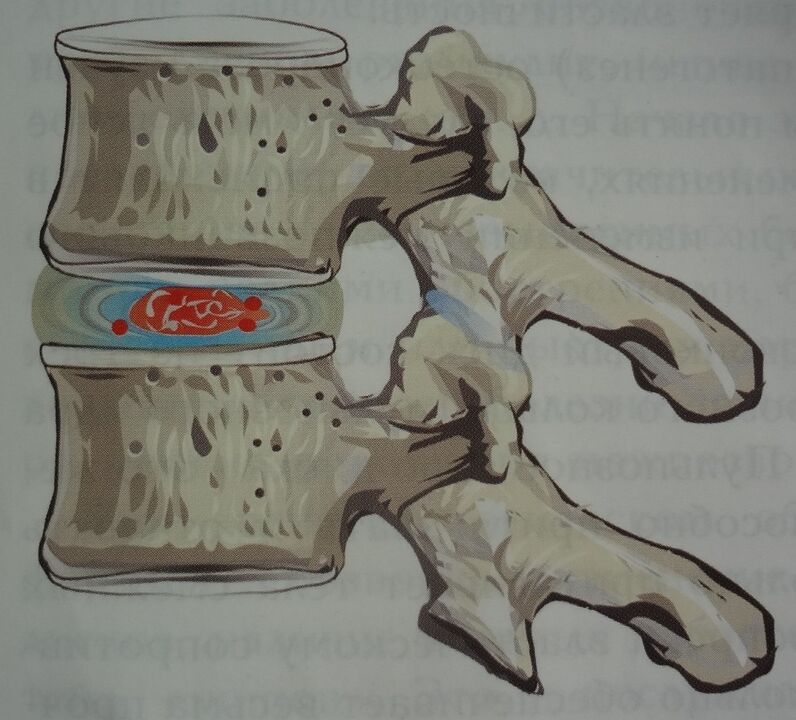
2 phases
At this stage, the fibrous ring is damaged, cracks and fissures appear on the surface of the intervertebral disc due to loads on the spine. The ring becomes thinner, the nucleus shifts into tears and cracks, which leads to their expansion. The enlarged disc protrudes beyond the vertebrae, the disc elongation occurs, the process is accompanied by pain.
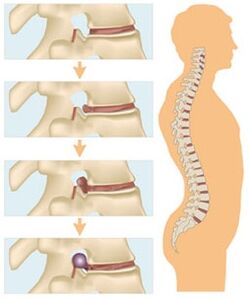
3 phases
With third-degree osteochondrosis, an intervertebral hernia forms, the fibrous ring is torn. The pulposus nucleus moves into the subglottic cavity, resulting in a disc herniation. The pathological process leads to damage to nearby vessels, muscle tissue, ligaments and nerves.
4 phases
This stage is accompanied by degenerative restoration of the spine, its duration reaches 12 months. During this period, there is a change in the nature of bone growth, they begin to grow in width, which leads to an increase in the vertebral area. Thus, the formation of osteophytes occurs, as a result of which the mobility of the spine is reduced, the destructive processes stop.

Treatment Methods
Treatment of any stage of cervical osteochondrosis in women should be aimed primarily at eliminating the causes of the disease. Therapy should be comprehensive, this approach will help to avoid further spread of the pathological process.
Treatment action should aim at restoring or activating lymphatic flow and venous outflow from the affected areas. Maintaining a healthy lifestyle is considered an excellent prevention and treatment of cervical osteochondrosis. As part of first aid, sedatives are indicated and NSAIDs are very effective.
After giving first aid, you should consult a doctor, he will help determine the appropriate treatment.
mEDICAL
In the treatment of osteochondrosis, the following drugs are prescribed:
- Non-steroidal anti-inflammatory drugs (tablets, injections) - their action is aimed at reducing pain, eliminating the inflammatory process. Therapy can last several months, while they negatively affect the functioning of the gastrointestinal tract.
- Steroid anti-inflammatory drugs (hormones) - prescribed for severe pain. They show effectiveness in eliminating inflammation, pain, but also have side effects in the form of a negative effect on the gastrointestinal tract.
- Antispasmodics - effectively relieve muscle spasms, have a relaxing effect on muscles, activate circulatory processes.
- Epidural blockade - during its application, the introduction of painkillers, hormones into the space between the meninges and the periosteum of the vertebrae is indicated.
As part of the treatment of osteochondrosis, the use of chondroprotectors, muscle relaxants, the dose and duration of therapy prescribed by the doctor is also indicated.
Gymnastics
Physiotherapy exercises for the symptoms of cervical osteochondrosis in women are recommended to be done according to the doctor's indications. All movements should be discussed with a specialist, as incorrect positioning of the neck and arms can worsen the situation.
Effective neck exercises:
- Lying with your arms outstretched to the side, lift up with slight body curves. The right palm should reach the left and vice versa, repeat 5-6 times.
- Lying on the abdomen with arms outstretched along the body, try to relax the muscles, turning the head alternately in different directions. The edges of the ears should touch the floor, do 10 repetitions.
- Standing straight with your shoulders straight, slowly turn your head in different directions, repeat 6-7 times.
- With fingers closed at the back of the head, join the elbows, connect the chin to the forearms, do 6-7 repetitions.
All exercises are recommended to be performed regularly, only in this case the effectiveness of therapy is achieved.
Physiotherapy and massage
Inhalation of the vertebrae is accompanied by severe pain, to eliminate the pathological manifestations of the disease, the doctor prescribes physiotherapeutic methods. Their action is aimed at eliminating pain, reducing unpleasant sensations and activating circulatory processes.
With osteochondrosis, the following physiotherapeutic methods are most often prescribed:
- shock wave therapy;
- electrophoresis;
- acupuncture;
- laser therapy;
- balneotherapy;
- massage.
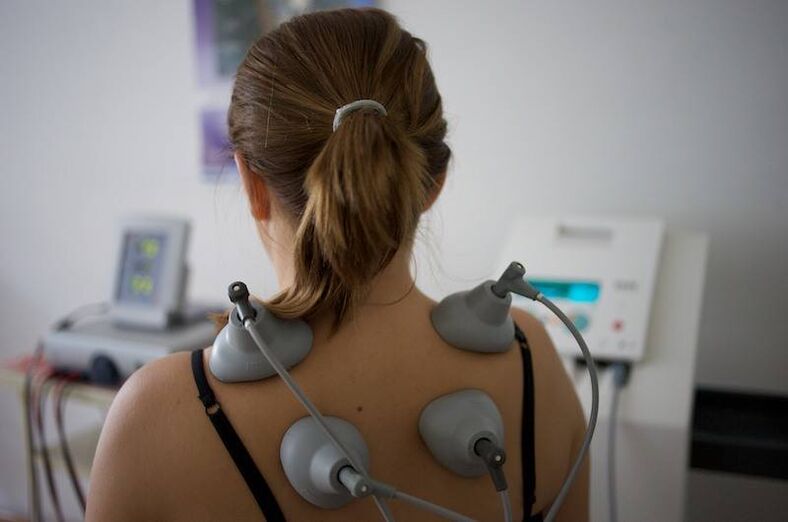
Massage shows effectiveness in eliminating pain, as a result, lost mobility returns. Physical impact on the affected area activates circulatory processes, reduces tone, strengthens muscles. The application of the method minimizes the risk of pathological processes in the future.
Different massage methods are used during the treatment, much depends on the clinical picture, the characteristics of the patient's body, the stage of the disease.
Massage has contraindications, which should be considered before prescribing the procedure. Caution should be exercised in case of vascular pathologies, as contraindications are also considered high blood pressure, injuries, skin inflammations.
Food
An important role in osteochondrosis plays diet, it should be balanced, it is best to contact a nutritionist. Consumption of salty foods and mineral water should be minimized. It is recommended to eat 5-6 times a day in small portions, fried, baked, spicy dishes should be replaced with steamed ones. It is recommended to give preference to protein products (legumes, dairy), chondroitin, whole grains, sesame. Prohibited coffee, alcoholic beverages, strong tea.

Alternative treatment
Alternative treatment is also recommended to be used in combination with traditional methods. A doctor's consultation is required first. Such methods can reduce the severity of symptoms, but not eliminate the cause of the development of the pathological process. As part of the popular treatment, ointments, infusions, decoctions, compresses, rubs, baths are widely used. Various herbs, alcohol, oils, honey, etc. are used in their production.
Effective recipes:
- Put a handful of chopped celery in 200 ml of boiling water, insist 5 hours, drink the drained mixture 1 tbsp. l. every day.
- Heat the green leaves of burdock or horseradish in a steam bath, apply on the neck for an hour.
- Mix honey and grated potatoes in equal proportions, use the compress mixture.

Therapeutic baths
The effect of therapeutic baths:
- thermal - under the influence of elevated temperature, circulatory processes are accelerated, intensified, the sensitivity of receptors increases, enzymes are activated, inflammatory processes are reduced;
- mechanical - under water pressure, blood circulation is activated, as a result, tissues are saturated with oxygen and useful elements;
- chemical - after the addition of salt, minerals, herbs, water acquires healing properties, baths also have a stimulating effect on the secretory system, as a result, the body's resistance to disease increases.
Coniferous baths, salt, mustard show high efficiency, the duration of the procedure is 20-30 minutes. After the session, it is recommended to lie down in a warm bed, as the cold can nullify the whole effect of the therapy. The procedure should be abandoned in the presence of cancer, heart problems and blood vessels.


















